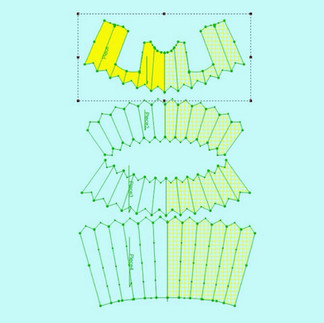Participants:
Shenkar college - Ori Topaz, Anna Solo, Ayelet Karmon;
University of the Arts London - Elisa Palomino Perez, Ana Cordoba Crespo
The paper "Making fish skin garments: developing digital tools for the fashion industry based on Ainu Indigious People's tradition", written by FISHSkin researchers Elisa Palomino Perez, Ori Topaz, Anna Solo, Ayelet Karmon and Ana Cordoba Crespo, was presented at the 2021 Responsible Fashion Series - Breaking the Mould conference at the University of Antwerp.
The research takes inspiration from traditional Ainu practices and explores the use of advanced digital tools to help integrate fish skins in contemporary fashion. The various digital tools are used to help ensure zero-waste designs, and enable the integration of different irregular unique shapes into one garment design.
Parallel to presenting the use of the digital tools, the researchers presented a replica of an Ainu fish skin robe, combining traditional Japanese Katazome Indigo dyes.
Robe assembly: Vanna Bellini. Katasome art: Takayuki Ishii.
Participants:
University of Arts London - Elisa Palomino
The report addresses the objective of innovating (traditional) creative and cultural industries and empowering cross-sectoral collaboration. The report, initiated by the Northern Dimension Partnership on Culture Strategy (NDPC) describes our project:
"FISHSkin (2019–2023) is a project that aims to increase the market take-up of fish leather to an industrial scale. It seeks to do this by integrating knowledge from different disciplines, Fashion Design, Material Science and Marine Biology, to form a new collective knowledge through which academic and industrial experts will strive to develop new techniques and methodologies."
Link to the Report
Link to FISHSkin contribution by our researcher Elisa Palomino of UAL. Pages 27, 34
Participants:
University of Arts London - Elisa Palomino
The film “Preservation of Hezhen Fish Skin Tradition Through Fashion Higher Education” will be premiered as part of the official selection of the Fashion Film Festival Milano (10th-13th December). The film, art directed by FISHSkin researcher Elisa Palomino, together with Zhongjin Zhang and Joseph Boon, focuses on the Hezhen society, one of China’s smallest ethnic minorities, living in north eastern China by the Amur river basin.
The film focuses primarily on identifying the historical, cultural, environmental and socio-economic importance of fish skin as an innovative sustainable material. It proposes a vision of sustainability as an anthropological study of the resourcefulness and resilience of the Arctic indigenous peoples, their lifestyles and fish skin practices. The application of the craft to fashion via sustainability practices has been tested through a participatory workshop with fashion students from Central Saint Martins taught by Hezhen craftspeople.
During the last century, Arctic indigenous peoples resisted both colonization and repression by humans, and dramatic ecological changes in seafood security. Fish skin craft became a way to communicate traditional knowledge combined with cultural resilience. In 2006, the Hezhen method of making fish skin clothes was listed as intangible cultural heritage, and Wenfeng You, the main craftsperson featuring in the film (alongside Sun Yulin), was appointed its heir.




















